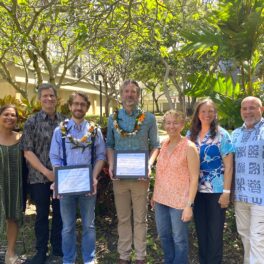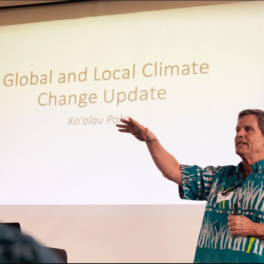New research provides ‘oases’ of hope for the future of coral reefs
 Coral reef in French Polynesia, rebounded from catastrophic damage in 2010. Credit: Peter Edmunds.
Coral reef in French Polynesia, rebounded from catastrophic damage in 2010. Credit: Peter Edmunds.
Amidst dire reports about the health of the world’s coral reefs, a team of 18 researchers, including several with ties to the Hawaiʻi Institute for Marine Biology (HIMB) at the University of Hawaiʻi at Mānoa School of Ocean and Earth Science and Technology, have found coral reef “oases” that provide hope all is not lost for these beautiful ecosystems.
The team, led by Peter Edmunds, California State University, Northridge marine biologist; Ruth Gates, HIMB director; and Ilsa Kuffner, a U.S. Geological Survey (USGS) research marine biologist, developed a framework for identifying specific coral reefs in the world’s oceans where corals appear to be thriving. They hope their findings, published in the June 18 issue of the Journal of Applied Ecology, will encourage further study into why these communities of corals are surviving while so many more are not, and inspire efforts to identify similar oases in other ecosystems.
The researcher team identified 38 oases locations categorized as either “escape,” “resist” or “rebound” oases. Escape oases are coral communities that have been able to avoid disasters such as bleaching, invasions from coral-eating sea stars or the wrath of hurricanes. Resist oases are coral communities that appear hardy and resist environmental challenges. Rebound oases are coral communities that have suffered damage like many other reefs, but have rebounded to a coral-dominated state.
HIMB’s Gates said she has been “blown away by the capacity of the some badly damaged reefs in Hawaiʻi to recover from past disturbances. There are areas in Hawaiʻi which are remarkable example of oases.”
With this study, the co-authors provide conservationists and policy makers with a tool to identify areas that warrant stronger protection or specific management strategies, as these intact ecosystems may be able to catalyze broader ecosystem recovery.
Also on the research team are HIMB graduate student Beth Lenz and HIMB alumna Hollie Putnam.
Read more on National Geographic, The Independent, Phys.org, NSF Discoveries, UH News.



